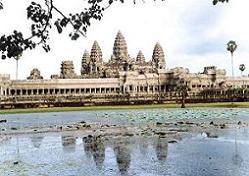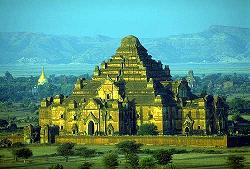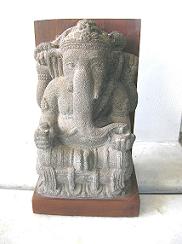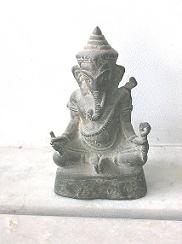Few people in India know that innumerable Ganesha temples exist from the medieval era in far flung countries like South and Central America, Mexico, Cambodia, Sri Lanka, Thailand, Indonesia, China, Japan and Iran. Huge modern edifices stand in Britain, Canada, Australia, France, Germany and the United States!
Media sources have said that the popularity of Ganesha has surpassed that of Buddha as an international icon!
Ganesha, with his primeval Omkar form, is considered to be Swayambhu. The one who just ‘is’. The one who creates himself and pervades everything, everywhere – so believe millions of his devotees. And truly, if you look closely, he can be found everywhere. A rough, gnarled tree trunk suddenly shows up an elephant-head like formation and people gather to admire the appearance of Ganesha. Rudrakshas, precious stones and beads, roadside rocks, coconuts, carrots and many objects of everyday use are often miraculously found to have the curled trunk or elephant-head shape formed naturally on them and all Ganesha worshippers look at these objects with devotion and cherish them. Many Ganesha temples in India – especially the Ashtavinayaka series in Maharashtra – stand in caves or caverns, on mountains and riverbanks. They are reputed to have idols that have formed themselves naturally out of the rock and are not carved by human hands. Such is the fame and popularity of this pot-bellied, beautiful, auspicious icon that generations of human beings from all over the world are fascinated by his lustrous personality, auspicious generosity and many-splendoured form!
In India, he is not only worshipped by Hindus, but also people of all faiths at least during the Ganesh Chaturthis in the months of Bhadrapad (August-September) and Magh (February-March) every year.
To most Indians, Ganesha is essentially a Hindu or Indian deity. From the smallest, dot-on-the-map-hamlets to the sprawling metropolises in India, every human settlement in India boasts many Ganesha shrines, natural or man-built. Apart from the famous shrines in historic sites like Chidambaram, Kanchipuram, Madurai, Mayurapuram, Nagapattinam, Trichy, Khajuraho, Prayag, Varanasi, Tiruvanthapuram and countless others, Ganesha shrines exist almost at every street corner in most Indian cities, towns and villages. Eminent scholars say that Ganesha icons are almost always found in places where people perceive danger of any kind – such as steep slopes, river crossings, and road crossings, sudden dips in the path or thickly forested jungles where wild beasts can attack human beings. Alice Getty, an American researcher who has authored a monograph on “Ganesha – Elephant-Faced God”, says that a large number of such idols, formed by Nature or Swayambhu, are found in the Kashmir valley. Three among these are famous pilgrimage centers. The first is near the Lidar River in Ganeshbal; the second is at the foot of the Hariparbat Hill near Srinagar and is called Bhimasvamin; the third and the most remarkable, is on a cliff along the Kishenganga River and is called Ganeshghati.
However, few know that Ganesha is truly a global deity! Ancient heritage temple sites and historic excavations show that worship of this elephant-headed god of wisdom and auspiciousness was widespread across continents! This reveals a historical truth – that Indian religion and culture influenced not only all the countries of South East Asia, but also countries as far as Mexico, South America, Iran and South Africa in the medieval era.
In more recent times, Ganesha temples have been built wherever Indians have formed communities in search of employment, trade or a global lifestyle. The temples of the latter category are found in Australia, Germany, France, United Kingdom, the Gulf countries and the United States. Some of the biggest modern temples of Ganesha stand in London, New York, Paris, Durban, Hamburg, Melbourne and Edmonton among international many cities.
However, it is interesting and important to present here some eye-opening information about the world’s most cherished historic heritage sites and the Ganesha temples that stand among their monuments. The neighboring island of Sri Lanka, today a wholly Buddhist country, has 14 ancient temples of Ganesha. In fact, many famous Buddhist temples like the one in Kelaniya on the banks of the Kelaniya Ganga River near Colombo have large Ganesha sculptures or friezes. Many Sri Lankans worship him and install him at the entrance of holy structures to invite his benevolence into their lives. The fourteen temples are found in Jaffna, Alaveddy, Batticaloa, Colombo, Kandy and Katargama. It is obvious that Indian culture and religion have had a strong influence on this emerald island.
Northwards, Nepal is a Hindu country with many cultural threads weaving its past with that of India. However, Nepal accepted the Tantrik cult of Hinduism, which is the religion of the majority in that country. Even today Hinduism in Nepal shows the influence of Tantrism. The Ganesha temples here show a slightly emaciated idol of the god with slanted eyes. Temples of Ganesha are found in Bhaktapur, Bubgamati, Chobar, Kathmandu, Gorkha, Janakpur and Phulhara.
Eastwards lie the ancient civilizations of Burma, Cambodia, Siam, Indonesia (Borabudur and Bali) and the Malay Peninsula. Of these, Burma’s Bagan Heritage Site and Cambodia’s Angkor Vat city are notable for their sacred geography and the mind-blowing number of shrines and sacred structures. They are recognized as the biggest historic temple sites in the world. The kingdom of Bagan in Burma dates back to the 2nd century AD but entered its golden age in 1057 AD. Until Kublai Khan ransacked the city in 1287 AD, more than 13,000 temples were built here – but with natural calamities like floods in the Irawaddy River or earthquakes and manmade losses like plundering and destruction, only 2200 remain today. Even then, this site rivals the biggest cathedrals of Europe. A number of these temples have Ganesha friezes at the entrances. But of all of them, the Shwesandaw temple, built in 1057 AD by King Anawrata, is called the Ganesha Temple because the deity’s images stood at the corners of each of the five terraces in the past. Ganesha was also the guardian deity of the Mons dynasty. Several other temples here have Ganesha icons in friezes and temple walls. It is agreed by scholars that Burmese culture was heavily influenced by the Chola Empire of South India.
Similarly, Angkor Vat was built by generations of Hindu kings who ruled Kamboja (the ancient name of Cambodia or Kampuchia) in medieval times. Naturally, Hindu deities like Vishnu, Shiva and Ganesha were consecrated in most temples. Now a UNESCO World Heritage Site, Angkor Vat, discovered by French archeologist Henri Mahout, still shows that Ganesha remains one of the most venerated deities in this splendid country of temples, lakes and rivers.
Next comes the story of Hindu influence in Java, Sumatra and Bali in present day Indonesia. Bali remains Hindu to this day, and the island has several Ganesha shrines. But Javanese Hinduism and Buddhism have also left behind several temples and monuments, which comprise Borabudur, a site that is counted among the Seven Wonders of the World. In this magnificent group of temples, Candi Sukuh and Candi Ceto are the last Hindu temples constructed towards the end of the Magapahit period of Javanese history. The Candi Loro Jongrang-Prambanan was built by the Sanjaya Hindu kings in the 7th-8th centuries and has splendid shrines dedicated to Shiva Mahaguru, Ganesha and Durga Mahishasuramardini. The Bara Temple in Tuliskaiyo Village in East Java, built in 1239 AD, boasts a three-meter high statue of Ganesha. So also Ratu Baka built in the 9th century AD shows an unfinished idol of Ganesha. However, Indonesia is an Islamic country today and no worship is offered at Ganesha temples except in Bali.
In Thailand, this is not so. Even in the hurry-scurry of modern day living, the Thai people, though largely Buddhist, still worship at Bangkok’s Ganesha temple and every Mahashivaratri, the Shiva Jhoola (Login Wor) is decorated in a public square. It is recorded that both Hinduism and Buddhism traveled to Siam from India when large settlements of Indians traveled to that country for trade and commerce, largely from Tamil kingdoms such as that of the Cholas. To this day, Thailand is called Sukothai – or the land of pleasant dawns – in ancient Tamil and Thai. Many words from Tamil have been incorporated in the Thai language. The ancient capital of Siam, Ayuthia, also reflects the strong influence of Indian religion and culture in that country. But here in Bangkok, Ganesha temple worship is different from that in India. The deity is offered food in the Buddhist tradition and includes non-vegetarian delicacies as well as cigarettes!
The Malay Peninsula was also strongly influenced by Hindu culture in bygone eras and temples of Ganesha were built in various locations including Petaling Java, Kuala Lumpur, Jalan Pudu and Melaka. Other countries, which have Ganesha temples, are Mauritius (in Riviere du Rempart) and Singapore.
Strangely enough, apart from oriental countries, Mexico, Guatemala, Peru, Bolivia and the Honduras have rich temples like India. Among the deities worshipped in these were Ganesha, Shiva, Vishnu, Hanuman and Surya. The icons permeated the Inca mythology and gained much influence in these countries. Ganesha idols from the temple of Diego Riviera in Mexico City, various Hindu images in the Guatemala Museum, Vera Cruz and Quiragua in Guatemala prove this adequately. Excavations in Mexico have revealed numerous Ganesha idols. Manuscripts found in that country show figures of the elephant-headed god and temple ruins in Central America have proved that Ganesha worship was also found in Aztec culture. Historians have also offered the theory that icons of Ganesha traveled to faraway countries on ships and that all sea-faring communities of traders accepted him as their guardian deity!
It is quaint that Ganesha changes his look and appearance depending upon the country and culture in which he appears. In Nepal, Thailand and other eastern countries, he has a Tantrik emaciated look and even carries hallucinatory plants in his hands. He wears caps and clothes typical of various countries. In Iran, he wears Zoroastrian robes. In Mexico and Central America, he wears the loose garments of Aztec civilizations. Ganesha also has innumerable names in countries and cultures that have loved him as the lord of prosperity, good luck and auspiciousness. In Hawaii, he is Lono; in South India and Sri Lanka, he is Pillaiyar, the noble child; for Tibetans, he is Ts’ogsbdag; to the Burmese, he is Maha-Pienne. In Mongolia he is Totkharour Khagan. Cambodians call him Prah Kenes and in Japan, he is Vinayaksa or Sho-ten. Some researchers even offer the theory that Romans knew Ganesha as Janus, the god of good beginnings, after whom they named January, the first month of the year. In every culture, he is worshipped in one form or the other. Today, millions of Hindus, Buddhists, Jains and Sikhs all over the world venerate Ganesha as the lord of success, prosperity, auspiciousness and the harbinger of plenty in every home and every human heart!
|

Angkor Vat – the world’s biggest Hindu temple – stands in a mammoth world heritage site in Cambodia. Ganesha is seen on the arched gates of several temples here. The Angkor Vat temple itself has friezes of Ganesha. The temple is seen here with its reflection in the waters of the Siem Riep River. |

The Shweshandow Ganesha Temple in Bagan, Burma, was built in 1057 AD by King Anawrata and enshrines some relics of the Buddha. It is called Ganesha Temple because in earlier days, icons of the god stood at the corners of all the five terraces of the temple. |
|

A stone replica of the Bara Temple idol of Ganesha in East Java. This idol stands three meters in height and typifies Java sculpture of its era. |

A metal Ganesha idol from Thailand shows him wearing a typical cap from that country. His features and posture are typically Thai in appearance. |
The pictures are taken by Prabhakar Patil.